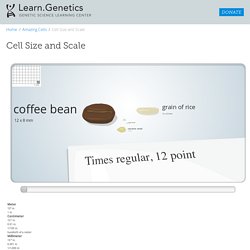

Doc 1 : Les familles des micro-organismes. Doc 1 : Les familles des micro-organismes. Doc 1 : diaporama du monde microscopique. Doc 2 : Les champignons microscopiques , levures et moisissures. Doc 3 : Les protozoaires. Doc 4 : Les bactéries. Doc 5 : les virus. Doc 6 : La taille des micro-organismes. Doc 6 :Cell Size and Scale. Some cells are visible to the unaided eye The smallest objects that the unaided human eye can see are about 0.1 mm long.

That means that under the right conditions, you might be able to see an ameoba proteus, a human egg, and a paramecium without using magnification. A magnifying glass can help you to see them more clearly, but they will still look tiny. Smaller cells are easily visible under a light microscope. It's even possible to make out structures within the cell, such as the nucleus, mitochondria and chloroplasts. To see anything smaller than 500 nm, you will need an electron microscope. Adenine The label on the nucleotide is not quite accurate. How can an X chromosome be nearly as big as the head of the sperm cell?
No, this isn't a mistake. The X chromosome is shown here in a condensed state, as it would appear in a cell that's going through mitosis. A chromosome is made up of genetic material (one long piece of DNA) wrapped around structural support proteins (histones). Carbon. Jeu MO. Jeu : Bactéries, virus et compagnie niveau débutant. Jeu : bactéries, virus et compagnie niveau intermédiaire. Doc 7 : Comparatif cellules procaryote et eucaryote. Doc 7 : Comparaison entre cellules eucaryotes et procaryote. Doc 7 : Comparaison entre cellules eucaryote et procaryote (suite) Doc 8 : facteurs de développement. Facteurs de développement des bactéries. Jeu : ces colonisateurs du corps humain niveau débutant. Jeu : ces colonisateurs du corps humain niveau intérmédiaire. Doc 9 : les fermentations.
Je fabrique du yaourt. C'est pas sorcier -CONSERVATION DES ALIMENTS : c'est dans boîte ! Jeu : Les fûtés de la propreté. Doc 10 : les micro-organismes en restauration. Les micro-organismes. Les micro-organismes : amis ou ennemis?